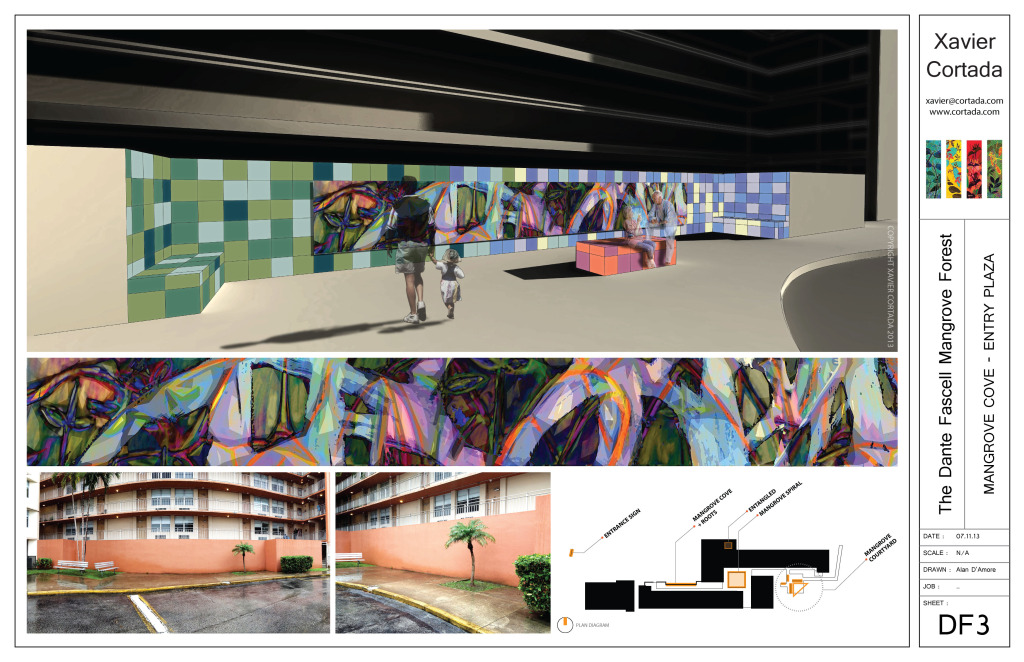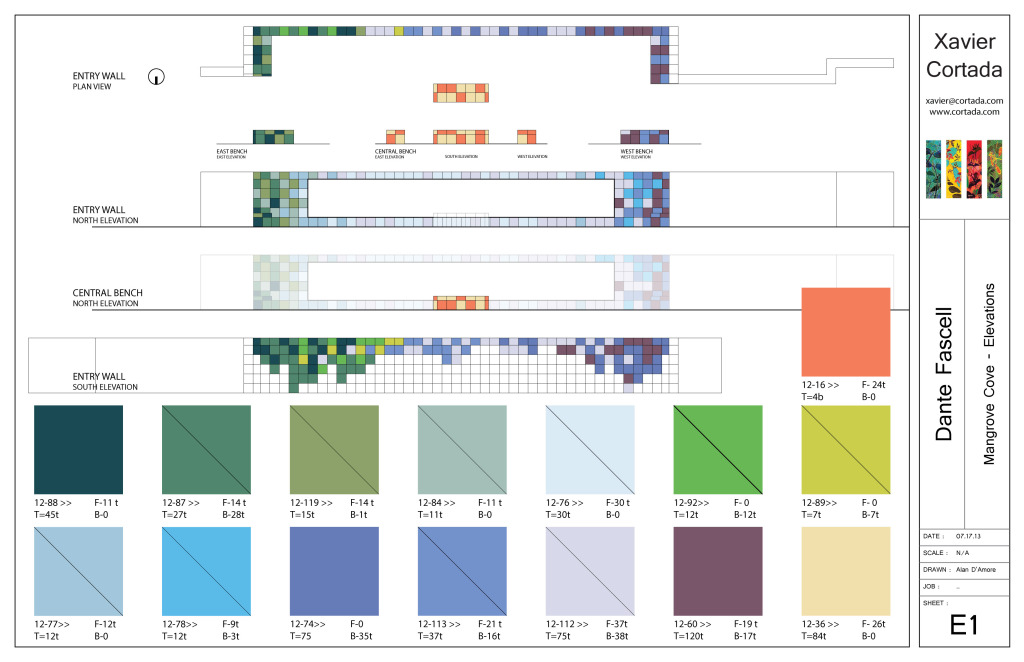Home » 2013 » Mangrove Cove » Mangrove Cove: About
Main | About
Mangrove Cove: Inspired by the image he once painted of Juan Ponce de León landing among Florida’s mangroves, the artist has created public art projects here that feature our unique coastal habitat. This building is named after congressman Dante Fascell, whose successful conservation campaign created Biscayne National Park.
 Xavier Cortada, “Mangrove Cove,” ceramic and glass mosaic, 2013
Xavier Cortada, “Mangrove Cove,” ceramic and glass mosaic, 2013
A public art project at Dante Fascell Apartments (Miami-Dade Housing Authority), Miami, FL
Click here to read the Miami Herald article
Artist’s Statement
My work aims to challenge us to find deeper meaning in our present lives by exploring the paths of those who came before us and our relationship to the natural world.
Dante Fascell Senior Living Community is a place where elderly folks with limited resources live, come together, build community and enjoy life. It is their sanctuary, their cove. Their home.
Placemaking was an important goal in this work. The plaza where the 32-ft long Mangorve Cove ceramic mural sits established a place to sit, socialize and enjoy each other’s company at the entrance of the building.
Materiality and texture are vital parts of the expression of this piece. Glass mosaic and ceramic tile that are hand painted and glazed are used to create a texture as exuberant and complex as the natural world the piece celebrates. The play of light, the movement of water and the gestural quality of the piece evoke natural processes, rhythm, movement, spontaneity and expressiveness.
I wanted to bring beauty to their world and bring nature to their lives and reference not just the person whom their building is named after, but also the neighborhood, Allapattah, which is the Seminole name for alligator.
When you walk by the water’s edge today you forget that there was a shack in 1914 and shortly before that, a mangrove forest.
I use mangroves to portray the journey and interconnectedness of Floridians. We all come from different places to make Miami our home, much like a mangrove seedling that washes up on a Florida sandbar sets roots.
Like others before them, the Seminoles walked the grounds where this building stands. They had a trading post on the Miami River just south of this very site wherethey traded with the early settlers. Wave after wave we come and build community.
I hope my art helps people think about what was here before and what immigrant groups came here, what kinds of struggles the people had to go through to get us to where we are. Context is what allows us to go forward in a sensitive and proactive way. To grow and to not take a look back is what is problematic.
The columns that hold up I-95 through downtown Miami reference what was there before the concrete was poured: in 2004, hundreds of volunteers joined me in painting colorful mangrove seedlings on columns across four neighborhoods, a metaphoric re-foresting and an invitation to locals to celebrate the cultural riches that made Miami.
This participatory practice grew out of seeing art as a vehicle to communication. I organized collaborative murals to give voice to those at society’s margins. Whether it was gang members in Northern Philly or street children in Bolivia — art became an instrument for problem solving. I’ve always wanted my art to be inclusive so that I’m working with the viewer to help change attitudes.
Ten years ago, in 2003, I started painting mangroves. Here in South Florida, they’ve given way to sea walls and development, but they’re important because they create an interface between land and water where marine life can take hold. Small fish find refuge from predators in their intricate roots, which also serve to protect the shoreline from erosion during hurricanes.
In 2006, I started putting mangrove seedlings in plastic water-filled cups and hanging them in the windows of retail shops on South Beach where they would have grown if we hadn’t destroyed their habitat. These vertical nurseries served not just to nurture the seedlings for future planting along Biscayne Bay but also invited passersby to join the Reclamation Project and participate in the reforestation.
A year later, in 2007, as a National Science Foundation Antarctic Artist and Writers program award recipient, I used the moving ice sheet that blankets the South Pole as an instrument to mark time, juxtaposing important events in human history with events that occur in broader geologic timeframes. There, I planted an ice replica of a mangrove seedling in the moving ice sheet. Embedded in the ice, the seedling will move 10 meters a year; in 150,000 years, it will arrive at the coastline and (theoretically) set its roots.
My work reaffirms the notion that we are simply custodians of the planet who should learn to live in harmony with nature. Today, the biggest threat we face is a lack of connection to one another and to our natural world. We have the capacity to liberate ourselves from this alienation. Our early ancestors found a way to become a part of natural balance as they populated the planet. Through my art I attempt to restore that balance. To engage others in reclaiming Florida’s fertile past.
